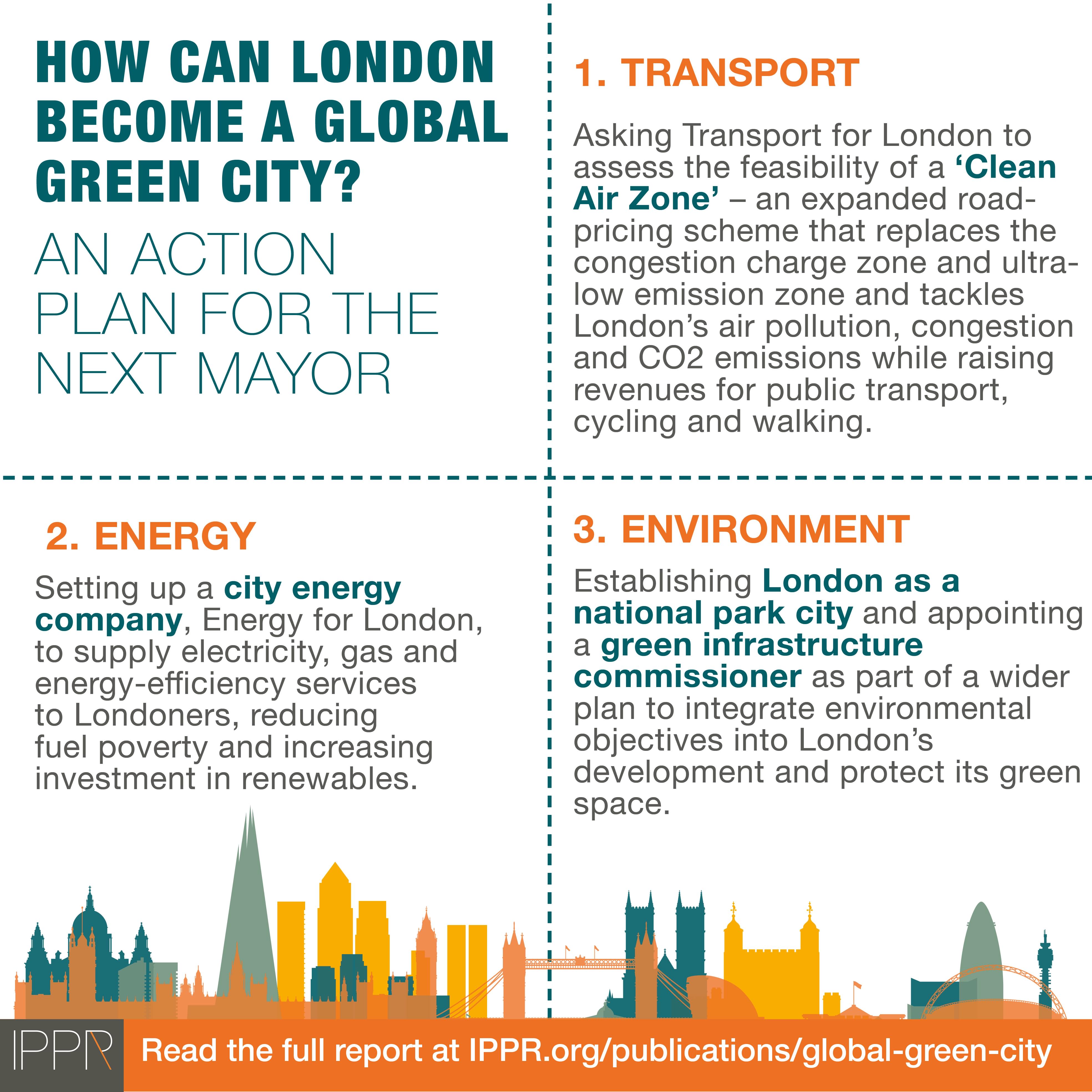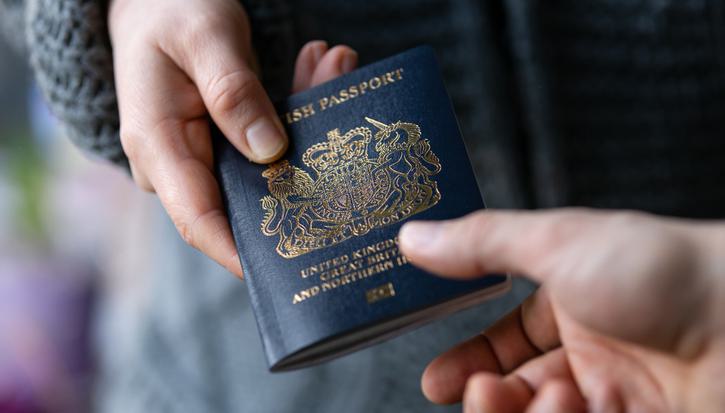London: Global green city
London, the global green city: Our plan for the next London mayorArticle
The mayor of London elected in May 2016 will face formidable environmental challenges. London’s air pollution is lethal and illegal, responsible for more illness and premature deaths than alcohol or obesity. Traffic congestion is rising. Greenhouse gas emissions are not on track to meet current targets, and around a million people live in fuel poverty. Green space is being lost to development. Recycling levels are the poorest in the country.
This report sets out a plan for the new mayor to address these challenges. It calls on the mayor to commit to making London a ‘global green city’, in which environmental goals are prioritised as central to the city’s vision of economic and social development.
The mayor should:
- Mandate Transport for London to assess the feasibility of an expanded road-pricing scheme that simultaneously tackles air pollution, congestion and CO2 emissions, and raises revenue for public transport, cycling and walking.
- Establish a city energy company, Energy for London, to supply electricity, gas and energy-efficiency services to Londoners and increase investment in solar power and renewable heating.
- Integrate environmental objectives into London’s planning, economy and community development strategies, including the establishment of London as a national park city and the appointment of a green infrastructure commissioner to promote the protection and enhancement of nature and greater public access to it.

- Sharethe mayor's global green London to-do list
Key challenges
- Air pollution in London was responsible for as many as 141,000 life years lost, or the equivalent of around 9,400 deaths, in 2010. This came at an economic cost of up to £3.7 billion. Driven primarily by emissions from transport, its impacts fall disproportionally on lower-income groups and children: nearly 25 per cent of school children are exposed to levels of air pollution that break EU and WHO legal and health limits.
- Without new policies to manage increased traffic demand, there will be an estimated 43 per cent increase in passenger vehicle miles between 2013 and 2030. The resulting congestion will decrease average road speeds, from 21mph today to an estimated 16mph by 2030, with speeds in central London significantly below this. Slower speeds mean greater delays and unpredictability in journey times, leading to higher economic costs.
- In 2013, around 10 per cent of households in London were classified as fuel poor, with an average fuel poverty gap of £304 per annum. London has some of the most energy inefficient housing in Europe, the highest average gas bills in the UK, and among the lowest rates of gas and electricity consumer switching.
- London must almost completely decarbonise by the middle of the century as part of the global effort to reduce net greenhouse gas emissions to zero beyond 2050, as set out in the Paris Agreement on climate change concluded in December 2015. However, London’s emissions reductions are currently off the pace required to meet the existing mayoral targets, which are themselves only part of the journey to full decarbonisation.
- Nearly 2 million Londoners live more than 1 kilometre from open green space, with a third of London families visiting natural spaces fewer than six times a year. The number of visits continues to decline, and at a higher rate among low-income and in some ethnic and minority groups. Between 2009 and 2012, more than 215 hectares of green space disappeared in London, an area equivalent to the size of Hyde Park and Battersea Park combined.
- Over 160,000 people already work in an environmental sector that saw over £25 billion of sales in 2011/12.
- London’s population is forecast to grow from around 8.5 million today to more than 10 million by 2031, and perhaps as much as 13 million by 2050, increasing demand for housing, transport, energy, water and other resources, with significant consequences for congestion, economic costs, public health, and the sense of space and social cohesion.
Key recommendations
The next mayor of London should aim to make London a ‘global green city’, in which environmental goals are prioritised as central to the city’s vision of economic and social development. The mayor should:
Tackle London’s air pollution and congestion problems by:
- Mandating Transport for London to assess the feasibility of an expanded road-pricing scheme bringing together the current congestion charging and ultra-low-emissions zones. Such a scheme, potentially covering the areas inside the north and south circular roads, would simultaneously tackle air pollution, congestion and CO2 emissions. It would raise revenue to reinvest in public transport, cycling and walking, to support the expansion of electric vehicles and car-sharing schemes, and to provide assistance to adversely affected small businesses.
- Ensuring the TfL bus fleet meets air pollution standards by 2019.
- Continuing strong investment in cycling and walking infrastructure, with a particular emphasis on safety.
- Expanding the electric vehicles charging network.
- Promoting car-sharing schemes, including the introduction of uniform on-street parking permits for car-sharing schemes across London.
Reduce fuel poverty and support renewable and decentralised energy by:
- Establishing Energy for London, a fully licensed electricity and gas supplier, energy services company, and energy manager for the Greater London Authority and Transport for London.
- Developing a dedicated solar strategy with a target to increase solar capacity to at least 750MW by 2025.
- Developing a dedicated efficiency and heat strategy to capture wasted heat and retrofit London’s homes and workplaces.
Integrate environmental goals within London’s planning, economic and community development strategies by:
- Establishing London as a national park city to provide an overarching vision and framework for the conservation and improvement of green space and biodiversity in the capital, encouraging wide public education and participation.
- Appointing a green infrastructure commissioner to promote the protection and enhancement of nature in London, with a long-term strategy to ensure everyone lives within 1 kilometre of open green space.
- Amending the London Plan to ensure housing intensification becomes a key characteristic of spatial development throughout London.
- Developing a feasibility and delivery plan for pedestrianisation across the city, building on the existing Mini-Hollands scheme.
- Promoting London’s green and low-carbon economic sectors, and working towards increasing London’s recycling and reducing its waste.
- Ensuring that London’s environmental policies draw on the expertise and engagement of London’s communities and civic organisations.
- Working with other cities and local authorities to establish UK100, a convening organisation that would help UK cities to fulfil their environmental ambitions.
Related items

Mission-driven industrial relations: The case for fair pay agreements
How fair pay agreements could support the government’s mission-based approach by resolving labour market challenges.
Women in Scotland: the gendered impact of care on financial stability and well-being
Women in Scotland are far likelier than men to take on childcare and other caring responsibilities, which puts them at an economic disadvantage.
Citizenship: A race to the bottom?
The ability to move from temporary immigration status to settlement, and ultimately to citizenship, is the cornerstone of a fair and functional immigration system.